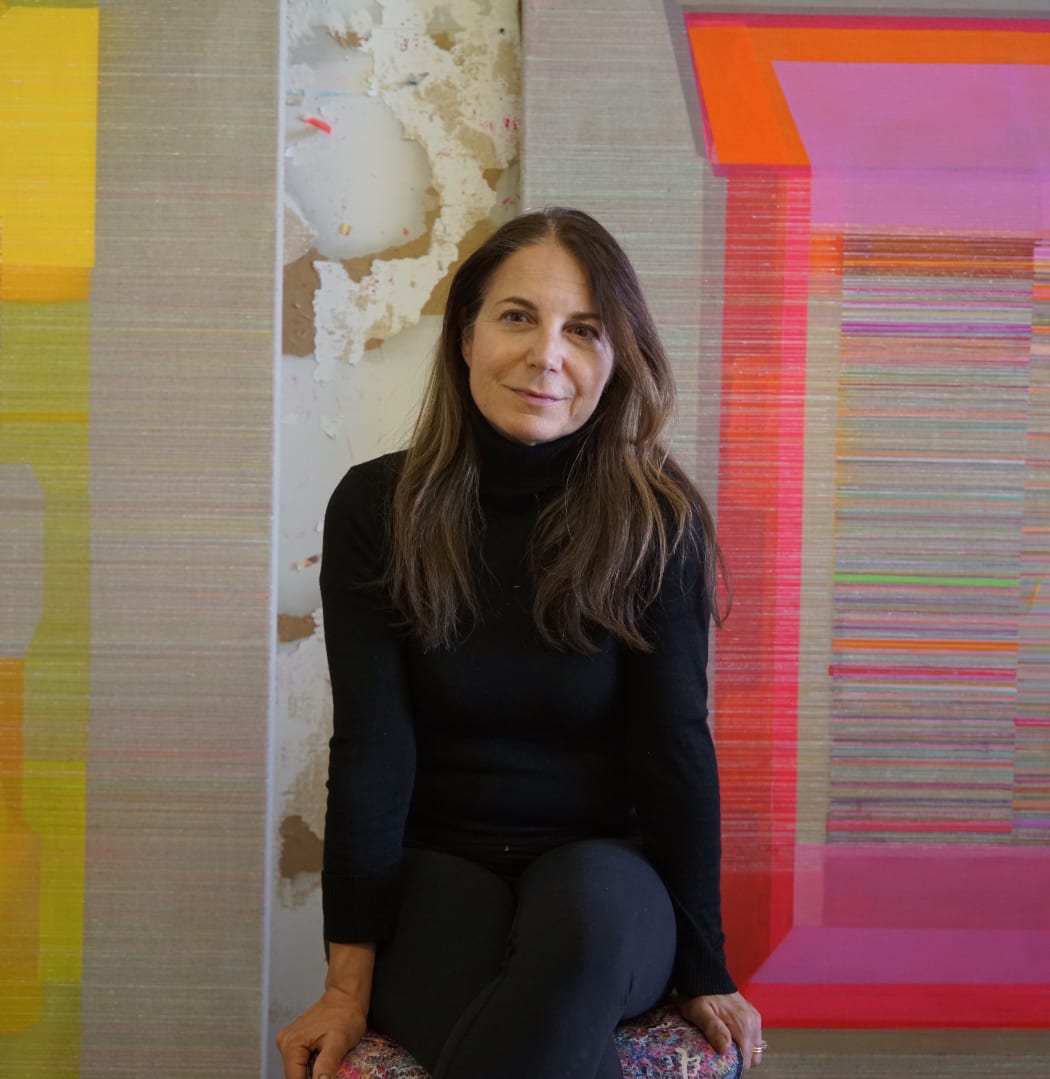
Canadian artist Antonietta Grassi employs a language of geometric abstraction to paint enigmatic forms that spark associations. Through her intuitive painting process of layering flat shapes and lines, she creates distorted three-dimensional objects influenced by memories and her environment.
Ronewa Art Projects talked to Grassi about the objects, spaces and histories that influence her forms and concepts. The online exhibiton 'Off Line,' featuring Grassi's recent works on paper, linen and canvas is live in the Ronewa viewing room from August 4 to September 4, 2021.
Read the exhibiton press release here.
April Dell: Memory is a dominant theme in your work. One reading of your imagery of three-dimensional, translucent objects is as receptacles or placeholders for memories. Are your forms based on actual objects or spaces from your life?
Antonietta Grassi: They are loosely based on memories and objects as a starting point, but it is very intuitive. I’m glad you mentioned translucency because this refers to how memories work - how we peel away one thin veil at a time to reveal more memories, but there always seems to be another layer.
I’m affected by the objects and spaces surrounding me, though my work is not a deliberate attempt to paint them. I start with a blank canvas and I have no idea where it’s going to go. It's almost like a recording of my thought process in that time frame.
The forms are primarily geometric because my visual language is rooted in that. I’ll start with a flat plane, a square or a distorted rectangle. And that goes on first. That sets up the dialogue of the painting, like a foundation, and I build on top of it.
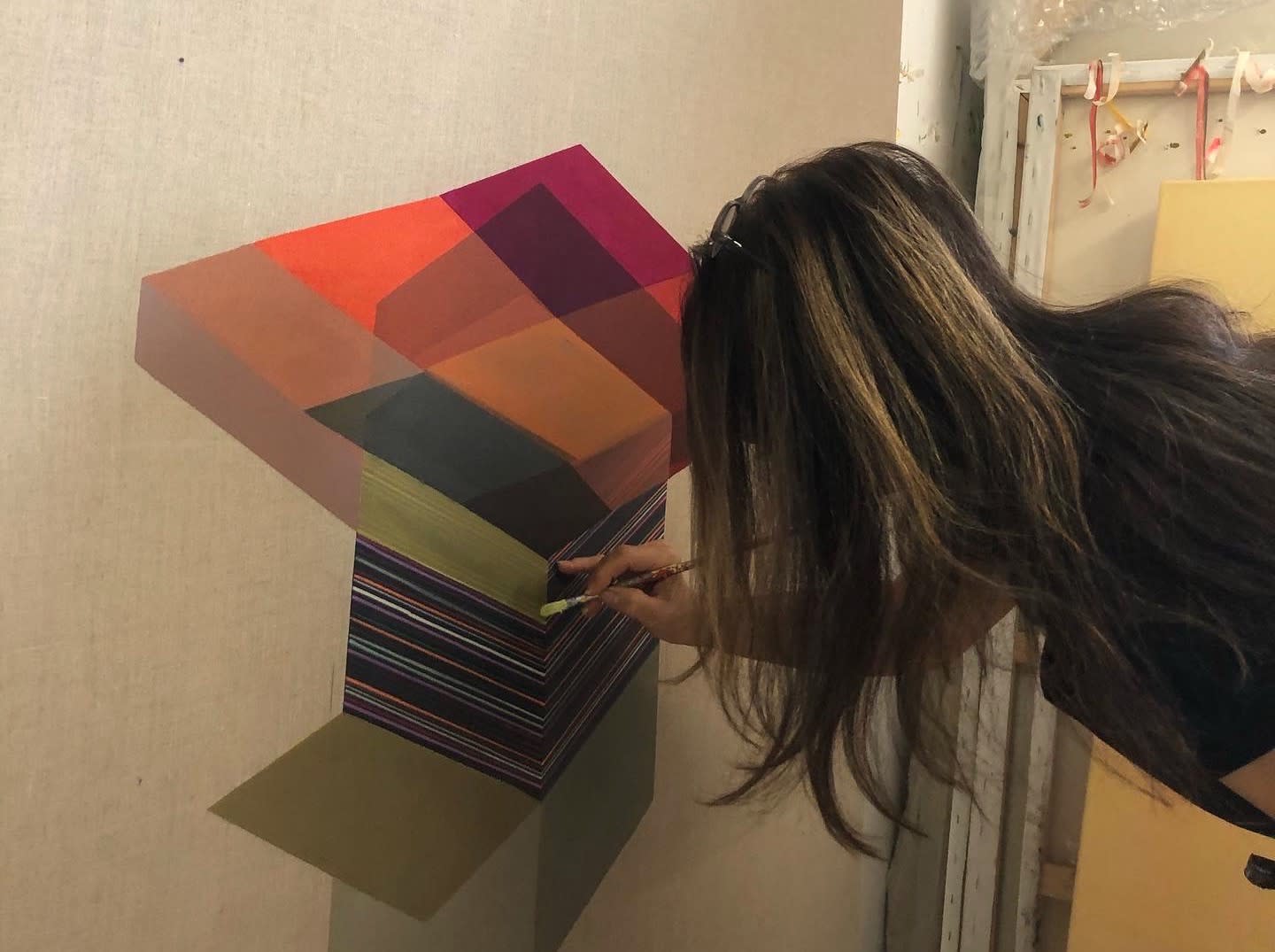
Antonietta Grassi working in her Montreal studio
AD: I get a sense of distorted space from your work, which has elements of reality and a dream-like or interior world quality. Are you influenced by theories of the subconscious mind or by art movements that attempt to communicate it?
AG: I think we all tap into memories and spaces from our past and that's why people resonate with certain things, like certain paintings, for example. I believe that our subconscious is always at work in each one of us. As artists, we are able to formalize it, to capture these fragments from the subconscious, put it into form, and try to make sense out of it.
As a child, I liked surrealism by artists such as De Chirico and Magritte. The imagery captures a lot of people’s imaginations. It contains recognizable elements, so there is an access point into the work. As an artist, I’m not influenced by surrealist imagery, but the movement paved the way for a lot of abstract art movements that came after it, which have inspired me.
AD: Your imagery and titles often reference analog or digital technology in some way, and you’ve written about your interest in the idea of obsolescence. Could you elaborate on this element in your work?
AG: I came of age during the transition from analog to digital. So I remember the first clunky home computers that were very physical with knobs and buttons. You could open them up and see inside them. As a user, you had some control over them.
The shapes in my work are based on memories of prosaic objects: filing cabinets, sewing patterns, old computers, and typewriters. In 2013, both of my parents passed away in a short period. Clearing out their home, the house I grew up in, I had to clear out all these outdated pieces of technology like fax machines and old computers. What once had a vital place in our lives had now become stuff that we were getting rid of it.
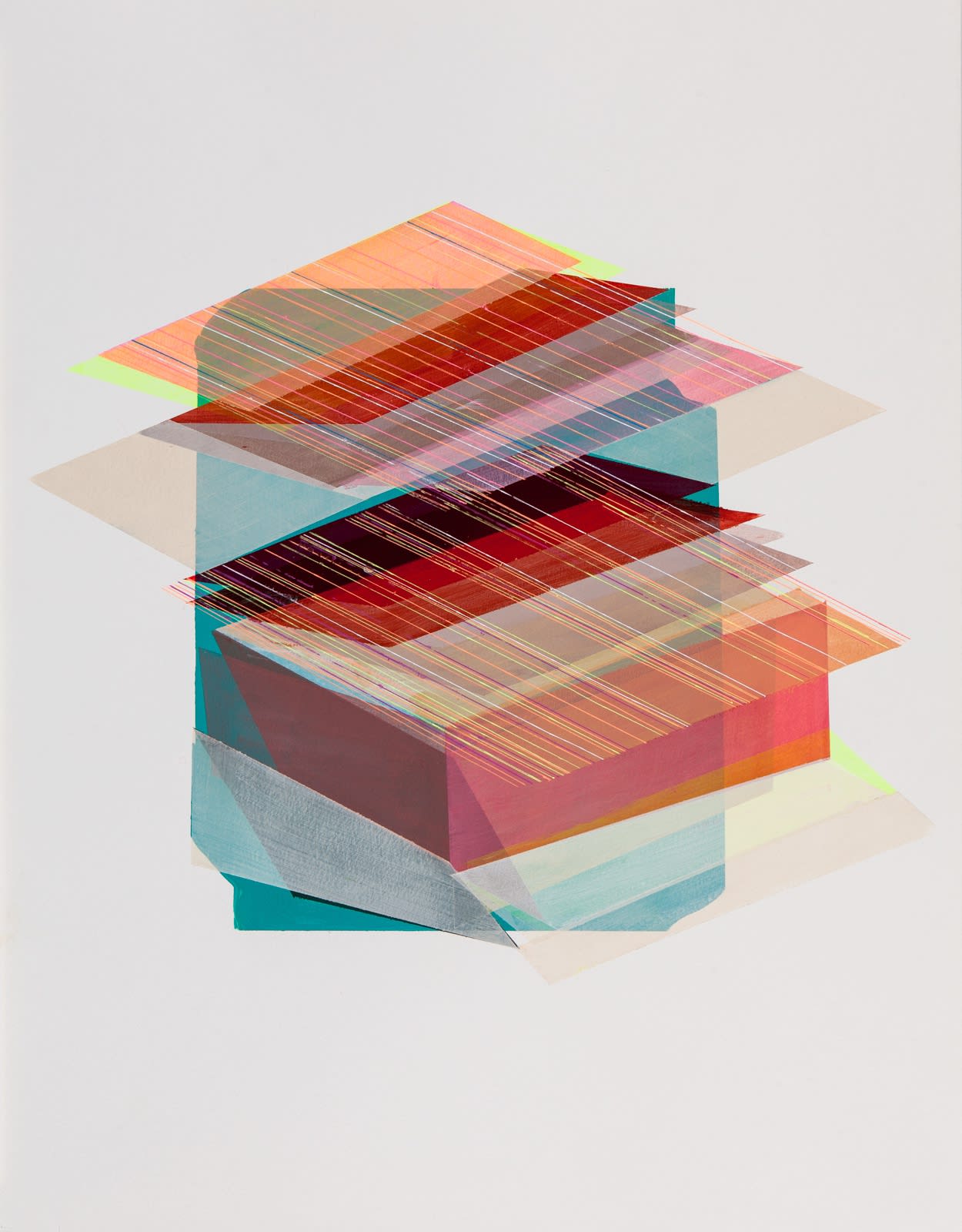
Leaving Things Behind, 2021, acrylic and ink on paper, 62.5 x 50 cm
Our technology has increasingly become more dematerialized: we swipe flat screens and store information in the cloud. Even though we’re supposed to be more connected and be able to do so much more, we have less and less control – it’s an unsettling place to be. Obsolescence is not only limited to technologies, it also relates to people and the jobs that have been erased because of technology. I started my creative career in the textile industry, an industry where entire towns would work for textile mills. Now many of those jobs have become obsolete because digitization has rendered human labour irrelevant and has devasted entire towns.
AD: The rows of thread-like lines that appear throughout your practice are reminiscent of weaving on a loom. In your work and thoughts about obsolescence, is traditional craft positioned in opposition to or adjacent to technology?
AG: I think it’s quite adjacent. I see craft and technology as interwoven. While working on my project ‘Lifelines,’ I was interested in the physical aspect of the textile loom and how it reminded me of barcodes. I did some research and was blown away by the historical link between the loom and the history of computers. The Jacquard loom, a machine invented in the 1800s that weaves patterns using punch cards, was an instrumental development in the history of computer programming thanks to Ada Lovelace and Charles Babbage. This loom has a very systematic way of creating patterns using punch cards, like a code. This technology that was initially invented for textiles inspired the first computer program. When you look at the weave of a fabric, it’s like a grid. So it’s very related to mathematics and data. I was happy to discover that there was an historical link between the two – a connection which I had intuitively felt was there before beginning my research.
As I dug further into the early days of computer programming, I realized that most of the programmers were women. I don’t think that history is very well known. My works are often titled after the women scientists and mathematicians in early programming or the programs they developed.
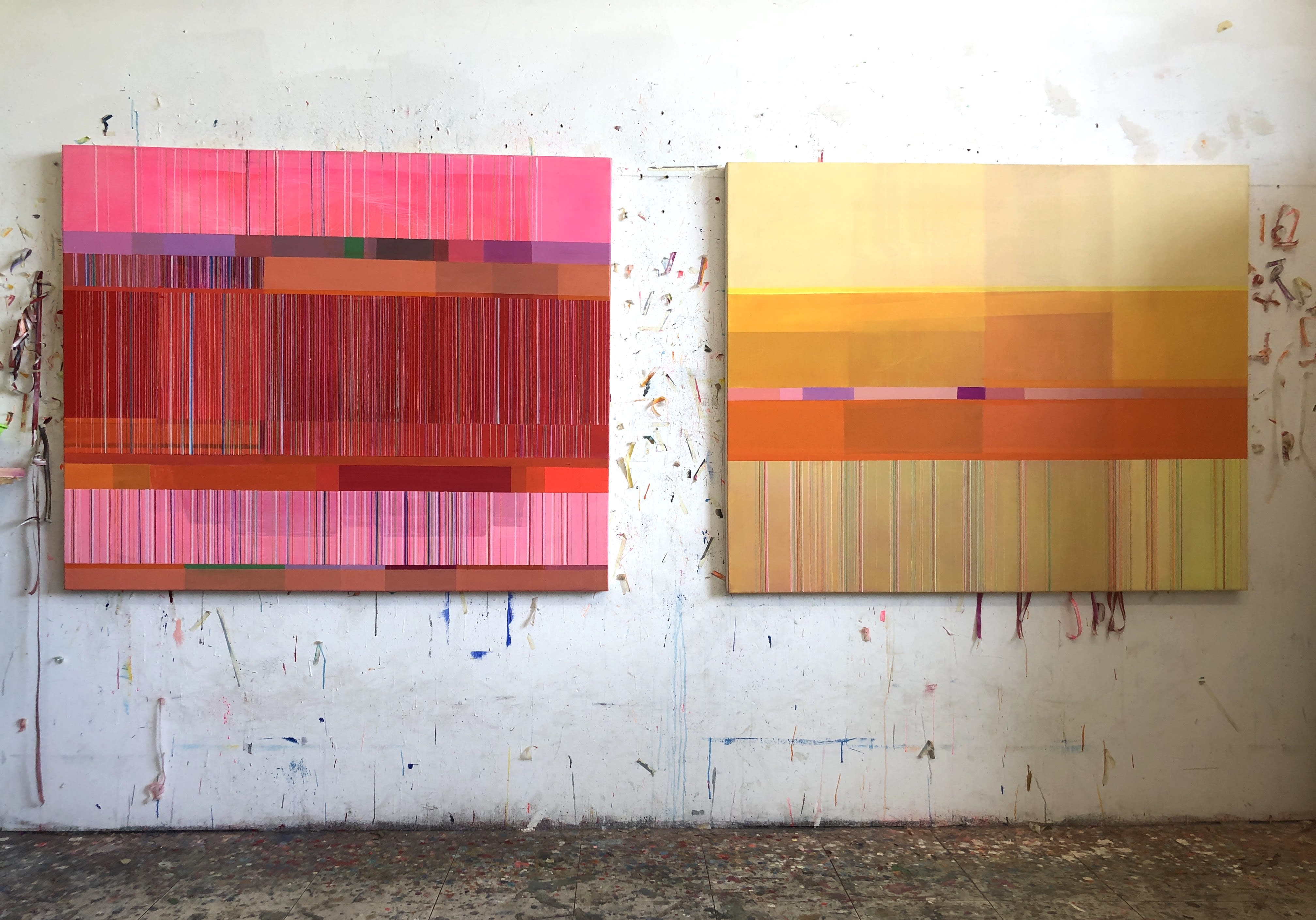
Studio view of canvas paintings by Anotnietta Grassi
AD: Your palette is often dominated by warm tones such as red, yellow, and pink. What draws you to these colors?
AG: I absorb a lot of my colors from what is surrounding me. Slight shifts in my environment activate changes in my work. I’m not aware that I'm doing it at the time. For example, a fluorescent orange showed up in my paintings that I later recognized was connected to an orange extension cord, which was the only object present in the sparse white studio I occupied during a residency. In 2017 I started to use a lot of hot pink in my work. Later, I realized I had been influenced by all these images of the women’s marches with pink hats.
While working on a series of works on paper, I had been using colored Post-It Notes to help myself keep track of things. The square shape and fluorescent colors made their way into my work. I called the series 'Posting,' which also acknowledges how obsessed we are with social media posts.
AD: Your painted lines and geometric forms are very neat but not mathematically precise. You can tell they have been hand-painted. How important is this particular painterly quality in your work?
AG: It is very important. I’m interested in this intersection between technology and the handmade. I like the ambiguity of how, at first glance, I could have done it on a computer. But I’m very much a painter and love work that reflects the handmade. I like the challenge of working with geometry and precision because it is slightly in opposition to how I think. Nothing is measured and everything is intuitive. I’m working against the grain and trying to contain myself somehow. I started to work this way after my parents died, where there was a lot of chaos surrounding me. It was a way to contain the chaos.
AD: You mentioned your process is intuitive. Can you expand on the way you work and how you achieve the forms that you do?
AG: There are two ways that I work or viewpoints that I work from. When I’m working on a very large piece, I’ll start on the floor and take a couple of items hanging around in my studio. It could be the remnants of a box or some old folders. I'll lay them out to figure out the spacing, how you might lay out a sewing pattern. From here, I alternate between building up the layers and painting the lines. For smaller works, I begin with the work upright and start with a square or rectangle and build it up from there. This way of working tends to produce three-dimensional shapes that you can see from multiple sides, with an almost cubist approach to perspective.
Painting the shapes and the lines are very different spaces to be in mentally because painting the lines is a very meditative process, whereas composing the shapes is a very active process requiring lots of back and forth decision making.
What I’m trying to reach through my process is perhaps elusive, like I’m always chasing something. That something is like magic. I want to be surprised by my own work; that’s when I know I'm on the right track. I build up each layer until something emerges. I have always thought of my work and the process of painting as working out a puzzle – a puzzle I set for myself. Sometimes the answer is not there immediately, and I need to step back and look at it with critical distance, perhaps like solving any problem.
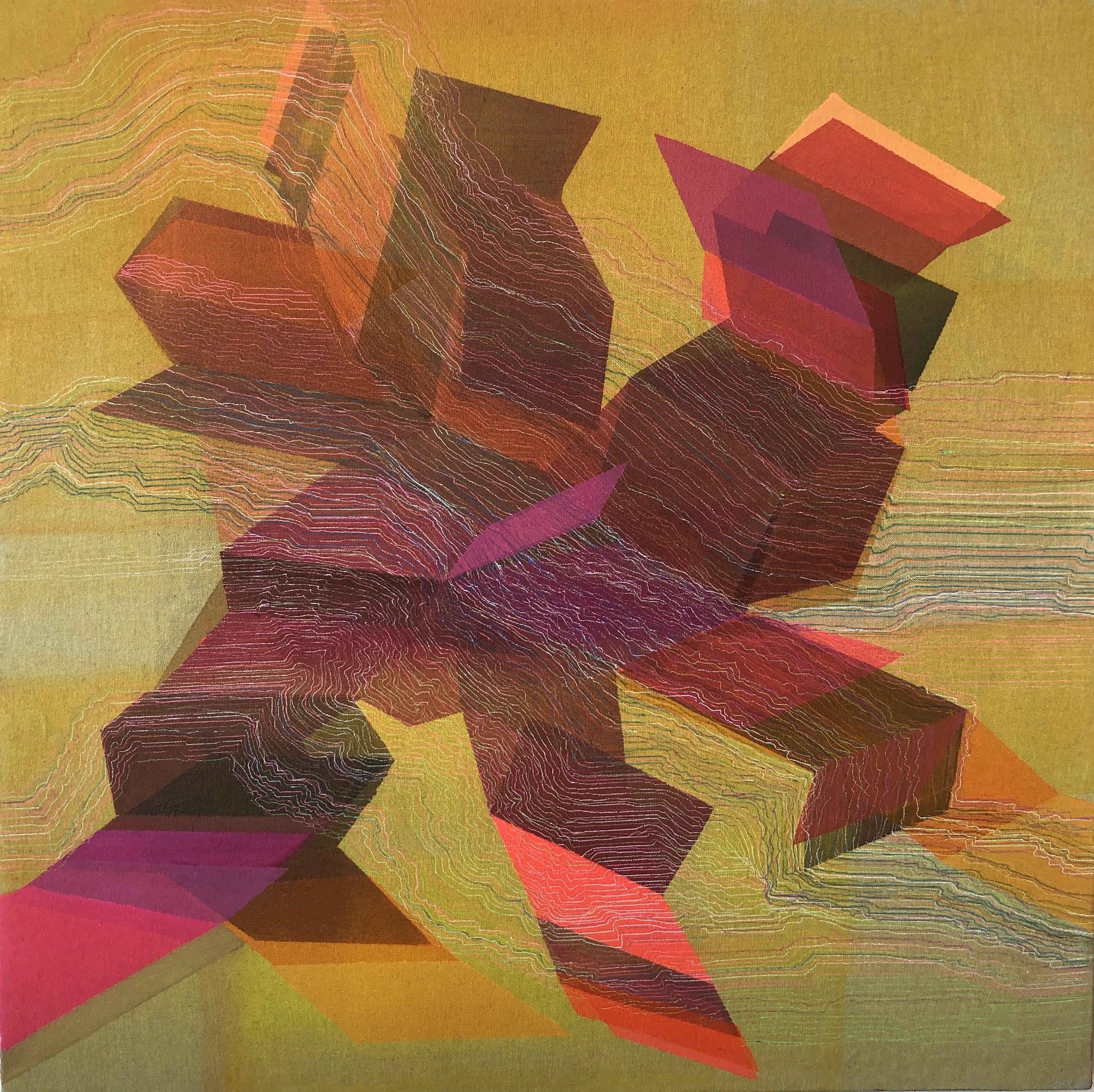
Tangled Topography, 2021, acrylic and ink on linen, 91.5 x 91.5cm
AD: The upcoming exhibition with Ronewa Art Projects will comprise works on canvas, paper, and raw linen. Do you achieve the same qualities or have a different process working with different materials?
AG: I really like working on paper because it’s where all of my ideas first come out and where I experiment. I tend to leave a lot of the negative space when I work with paper. I do that with raw linen as well. I like that the material becomes an important visual element. I feel like I can be less stubborn about solving the puzzle because I can leave it relatively fresh and minimal. In contrast, my canvas paintings are typically full of color with completely painted surfaces.
AD: Some of the concepts and memories behind your practice are very personal. What are some of the interesting ways viewers interpret or connect with your work?
AG: When I've had the privilege of receiving feedback on my work through submissions or collectors, they’ve often said it reminds them of something, but they’re unsure exactly what it is. It taps into their vague memories in the same way that I tap into my memories while I work.
For instance, my work resonated with a Canadian collector whose family collected fine linens and it reminded her of her ancestors. This happens a lot, the textile element reminds many people of childhood memories.
Someone who came to my show in April was captivated by one of my seven-foot linen works. He had been a data analyst and asked me if I was interested in data. So he was coming t it from another angle. For others, it might give them the feeling of tech, yet with a physical and material aspect t to it. I sense people’s need for something to touch, and there is something comforting in this tangible aspect.
AD: Considering the last year and a half, how have the challenges of the COVID-19 pandemic impacted your practice as an artist or the content of your work?
AG: I was really lucky when it hit here in Montreal in March because I could continue to go into my studio and keep working. A lot of my exhibitions were postponed, and within this indefinite time frame, working became a marker of the time passing.
Of course, there was the looming collective anxiety and uncertainty. I titled my recent series ‘Lifelines’ because going to the studio and having that consistency and that meditative process of painting was like a lifeline for me. There is also this historical line between textiles and early computer programming and the role of women in this history, which brought me to this particular series.
Perhaps this period did have an impact on my work, but I won't really know that for certain until I have more distance and can look back at this moment in time with the perspective that only the passage of time can offer.
Images courtesy of the artist.
Online exhibition:
Antonietta Grassi – Off Line
August 4 – September 4
Ronewa online viewing room
Ronewa Art Projects
Email: contact@ronewa.com Website: www.ronewa.com


Add a comment